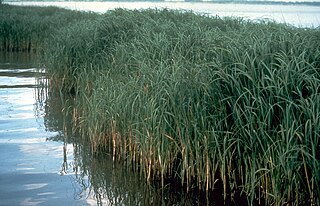
A halophyte is a salt-tolerant plant that grows in soil or waters of high salinity, coming into contact with saline water through its roots or by salt spray, such as in saline semi-deserts, mangrove swamps, marshes and sloughs, and seashores. The word derives from Ancient Greek ἅλας (halas) 'salt' and φυτόν (phyton) 'plant'. Halophytes have different anatomy, physiology and biochemistry than glycophytes. An example of a halophyte is the salt marsh grass Spartina alterniflora. Relatively few plant species are halophytes—perhaps only 2% of all plant species. Information about many of the earth's halophytes can be found in the halophyte database.
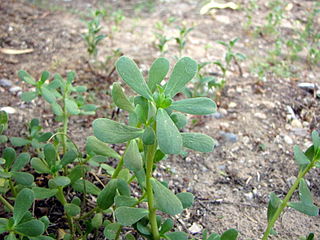
Portulaca oleracea is an annual succulent in the family Portulacaceae.

Juniperus indica, the black juniper, is a juniper native to high-altitude climates in the Himalaya, occurring in Pakistan, India, Nepal, Bhutan and China.

The Salicornioideae are a subfamily of the flowering plant family Amaranthaceae. Important characters are succulent, often articulated stems, strongly reduced leaves, and flowers aggregated in thick, dense spike-shaped thyrses. These halophytic plants are distributed worldwide. Many are edible

Opuntia ficus-indica, the Indian fig opuntia, fig opuntia, or prickly pear, is a species of cactus that has long been a domesticated crop plant grown in agricultural economies throughout arid and semiarid parts of the world. O. ficus-indica is the most widespread and most commercially important cactus. It is grown primarily as a fruit crop, and also for the vegetable nopales and other uses. Cacti are good crops for dry areas because they efficiently convert water into biomass. O. ficus-indica, as the most widespread of the long-domesticated cactuses, is as economically important as maize and blue agave in Mexico. Opuntia species hybridize easily, but the wild origin of O. ficus-indica is likely to have been in central Mexico, where its closest genetic relatives are found.

The glassworts are various succulent, annual halophytic plants, that is, plants that thrive in saline environments, such as seacoasts and salt marshes. The original English glasswort plants belong to the genus Salicornia, but today the glassworts include halophyte plants from several genera, some of which are native to continents unknown to the medieval English, and growing in ecosystems, such as mangrove swamps, never envisioned when the term glasswort was coined.

Mesembryanthemum crystallinum is a prostrate succulent plant native to Africa, Sinai and southern Europe, and naturalized in the New World. The plant is covered with large, glistening bladder cells or water vesicles, reflected in its common names of common ice plant, crystalline ice plant or ice plant.
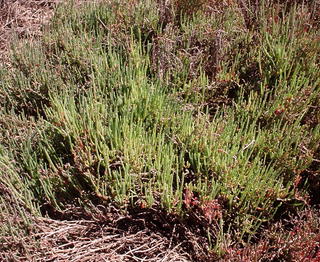
Tecticornia is a genus of succulent, salt tolerant plants largely endemic to Australia. Taxa in the genus are commonly referred to as samphires. In 2007, the genus Halosarcia, along with three other Australian genera was incorporated into the genus.

Tecticornia arbuscula, the shrubby glasswort or scrubby samphire, is a species of plant in the family Amaranthaceae, native to Australia. It is a shrub that grows to 2 metres in height, with a spreading habit. It has succulent swollen branchlets with small leaf lobes.

Tecticornia pergranulata is a succulent halophytic plant species in the family Chenopodiaceae, native to Australia. This plant is commonly tested in labs involving its C3 photosynthesis and its unique resistance to salinity and adversity.

Kalimeris indica, also known as Indian aster or Indian Kalimeris, is a flowering herbaceous perennial plant of the family Asteraceae (Compositae). Kalimeris indica, like other species in the genus of Kalimeris, occurs mainly in eastern Asian countries of China, Korea and Japan, and has been introduced to California and Hawaii.

Duma florulenta, commonly known as tangled lignum or often simply lignum, is a plant native to inland Australia. It is associated with wetland habitats, especially those in arid and semiarid regions subject to cycles of intermittent flooding and drying out. The Wiradjuri name for the plant is gweeargal, and the Walmajarri name is Kirinykiriny, or Kurinykuriny.

Cleome viscosa, the Asian spiderflower or tick weed is an annual herb that grows up to a meter high. It belongs to the family Cleomaceae. It is considered an invasive species and is widely distributed in warm and humid habitats across the Americas, Africa and Asia, and in Australia. It is commonly found during the rainy season.
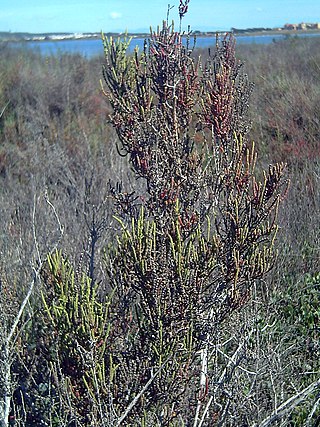
Arthrocaulon macrostachyum, synonym Arthrocnemum macrostachyum, is a species of flowering plant in the amaranth family. It is native to coastal areas of the Mediterranean Sea and the Red Sea and parts of the Middle East, where it grows in coastal and inland salt marshes, alkali flats, and other habitats with saline soils.

Aeluropus lagopoides, sometimes called mangrove grass or rabbit-foot aeluropus, is a species of Eurasian and African plant in the grass family, found primarily in salty soils and waste places.

Microcnemum is a genus in the plant family Amaranthaceae, containing a single species, Microcnemum coralloides. It is a dwarf annual halophyte with fleshy, apparently jointed stems and reduced leaves and flowers. The two subspecies show a disjunct distribution in Spain and Western Asia.
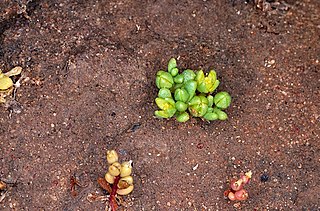
Gunniopsis septifraga, commonly known as green pigface, is a species of flowering plant in the iceplant family, Aizoaceae and is endemic to Australia. It is a prostrate to tuft-forming annual herb, with oblong to lance-shaped leaves and small greenish flowers, that grows around salt lakes.
Kelly Anne Shepherd is an Australian botanist, who has published some 91 names.

Tecticornia verrrucosa is a species of plant that is succulent and halophyte. This plant was a member of the Chenopodiaceae, which are now included in family Amaranthaceae.
Tecticornia lylei, commonly known as wiry glasswort, is a small shrub with in the family Chenopodiaceae. It occurs in saline clay soils on the beds of and around the perimeter of salt lakes. The erect shrub can grow up to 1 m in height and 1.5 m wide, and has slender branches with very slender branchlets, its articles cylindrical, dull mid-green and about 3 mm long and 2 mm wide. The wiry glasswort flowers between November and June, with tiny flowers less than 3 mm across which fruit when pollinated. Listed as endangered in New South Wales and rare in Victoria and South Australia, T. lylei is threatened by trampling and overgrazing, vegetation clearing and stochastic events.



















